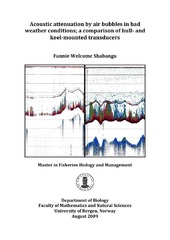Acoustic attenuation by air bubble in bad weather conditions; a comparison of hull- and keel-mounted transducers
Abstract
Echo integration in bad weather conditions is problematic due to vessel- and wind-induced air bubble layer that is formed below the hull of a vessel, where acoustic transducers are mounted. The bubbles below the hull attenuate both the transmitted and received acoustic waves and may lead to an underestimation of the real fish abundance or density. A detailed understanding of the acoustic energy attenuation by the air bubble layer is crucial for establishing a correction factor for the recorded echo integrator measurements. The acoustic attenuation by the air bubble layer under different weather conditions were estimated by observing the ratio of the nautical area backscattering strength of the sea bed between two inter-calibrated Simrad EK60 38 kHz hull- and keel-mounted transducers. By integrating the sea bed as a reference target over distance in various weather conditions, the amount of acoustic signal attenuated by the air bubbles was estimated. A correction factor for the hull mounted system was further established from the data. The consistency of the bottom backscattered ratio was investigated in various wind speeds, and the best consistency of the ratio was found in periods with calm wind speeds (0-10 m/s). The results indicated that the estimated ratio strongly increased with wind speeds (Beaufort force) but at a lower magnitude than earlier reported and expected at 38 kHz. This indicates that the necessary corrections are less than earlier reported at similar wind speeds. This is however vessel specific, and may be effected by the transducer mounting position and by the shape of the vessel hull. There was a significant difference between the echo integrator values of the hull- and keel-mounted transducers, with the keel-mounted transducer performing better in all various weather conditions. In very bad weather, however, the data indicated that also the keel mounded transducer experienced air bubble attenuation as well. A strong correlation between the bottom backscattering strength responses of the two-transducer mounting systems was found, while a rather low correlation between the vessel pitch/roll and bottom backscattering strength was found. In conclusion, a new and modern technique of estimating a correction factor for air bubble acoustic attenuation was tested and verified. Since the investigations were made as a secondary or third priority objective during the surveys, a better material can be collected if special surveys are conducted for air bubble estimation. Especially when using this method with the vessel running in several directions into the wind should then be considered.
Description
Revised version: Spelling errors corrected
Publisher
The University of BergenCopyright
The authorCopyright the author. All rights reserved
